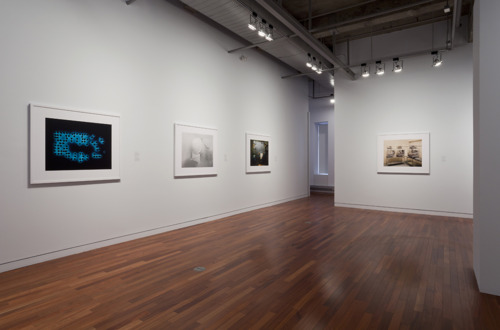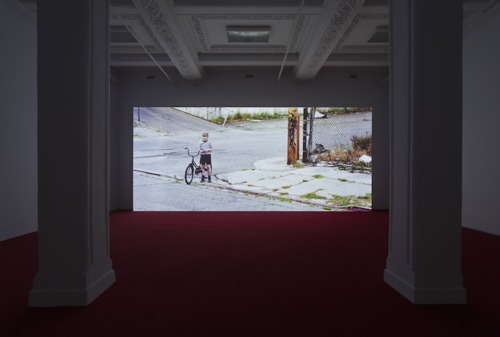Visions of Surveillance, of Witnessing and of Mourning: The Art of Emmanuelle Léonard, Taryn Simon and Philippe Parreno
Visions of Surveillance, of Witnessing and of Mourning: The Art of Emmanuelle Léonard, Taryn Simon and Philippe Parreno
As a new initiative since January 2012, DHC/ART invites an artist to conceive a hands-on workshop for the Education program to be presented within the framework of its current exhibition. Par les yeux du surveillant/Through the Eyes of the Monitor is the first of these projects created by artist Emmanuelle Léonard and is aimed at an exploration of the themes and approaches put forth in the exhibition Chronicles of a Disappearance. During this workshop, participants are presented with a sequence of footage that has been captured by the Foundation’s surveillance cameras. They adopt the perspective of these monitoring ‘eyes’, located high above, fixed on the galleries’ ceilings. These ‘eyes’ have the task of maintaining order and safety within the spaces where art is displayed and received, as well as document inappropriate and threatening behaviour, inciting DHC/ART workers to intervene if necessary.

The technology of these surveillance cameras is such that these black and white images are blurred, dark and the movements of the visitors are jerky and broken, with bodies that are difficult to distinguish from one another. Is this unclear image the type of image that we use to select who may be guilty? It would seem to be the case. And at what point do we decide that a certain behavior constitutes a threat to the artworks, to other visitors, or to DHC/ART staff? At what specific moment does disorder begin in the exhibition spaces? Is it when too much love brings an art admirer to get dangerously close to an image? Or when one gallery-goer has been following another gallery-goer for too long a time? At what stage does this become uncomfortable and suspicious? These are just a few hypothetical questions which come to my mind when I imagine participating in the Par les yeux du surveillant/Through the Eyes of the Monitor workshop.

With her series of photographs An American Index of the Hidden and Unfamiliar, Taryn Simon sheds light on numerous hidden, unseen, highly guarded sites located within the borders of the United States, these sites which eloquently speak of American culture and towards which she has fascination. She is extremely tenacious and hard working at this task; as a photographer, the majority of her time and energy is not spent at taking photographs, but rather it is spent at trying, re-trying and persisting in gaining access to these secret, faraway places.
What are these secret worlds? Among others, one is inhabited by exotic birds in quarantine, immobilized in cages; another is peopled with dead bodies, frozen in cryopreservation units, in hope of future re-animation; another one contains 1,936 stainless-steel nuclear-waste capsules, highly radioactive, submerged in water, which serves as a shield against radiation; and again, in another, we can see a black bear mother and her cubs hibernating in their den, their body temperature decreased from approximatly 104 to 94 degrees Fahrenheit.
Taryn Simon wants to approach these places as close as she possibly can, with bravery, because they are risky, often dangerous, for anyone who dares visit. And when she arrives there, when she is inside that place, she has worked so hard and for so long at gaining access to it, that this obscure site seems to gain, in her view, a sudden clarity. In his foreword to the book An American Index of the Hidden and Unfamiliar, Salman Rushdie states: ”Simon’s is not the customary aesthetic of reportage — the shaky hand-held camera, the grainy monochrome film stock of the ‘real’. Her subjects (…) are suffused with light, captured with a bright, hyper-realist, high-definition clarity that gives a kind of star status to these hidden worlds, whose occupants might be thought to be the opposite of stars. In her vision of them, they are dark stars brought into the light. What is known, rarely seen, possesses a kind of occult glamour, and it is that black beauty that she so brightly, and brilliantly reveals.”
At destination, for a moment, she puts down her photographic equipment, assembles and installs her camera, takes a picture, sheds light, steps back and takes her distance once more. A physical imprint has been transferred onto a sensitive surface. One more image for her collection.

Philippe Parreno’s filmic installation June 8, 1968 re-creates the historical train ride when the assassinated body of Senator Robert Kennedy, lying in a coffin in one of the train cars, was transported from New York to Washington. On that day, mourners gathered along the tracks to pay their last respects. The vision Parreno offers to us, the film installation viewers, is one which is greatly mobile, modulated by varying and diversified rhythms. As spectators, our body and vision are sometimes deeply grounded in the earthly terrain and sometimes aerial, suspended and hovering in space. At one time, our eyes are inside the train, looking outside, from the windows, and a few seconds later our eyes seem to be on top of the train, then beneath it, rushing furiously on the tracks. At other moments, we are abruptly transported in the sky, at the height of a majestic tree, very slowly sliding down towards it’s roots. Going back in the air, we are now stroking the surface of a hill, until landing on the ground, and taking a pause, on a nearby sidewalk, of a nearby small town.
I remember a student in one of my tours who suggested: “this floating and aerial vision might be the vision of the spirit of Robert Kennedy”. A very inspiring interpretation. All through the film, we are sometimes adopting the point of view of the body inside the coffin, and sometimes it’s haunting spirit.
Marie-Hélène Lemaire
DHC/ART Education
Photos:
Rushdie, S. (2008). Foreword. In A. Watters & A. Wasow (Eds.) An American Index of the Hidden and Unfamiliar. (p. 7). Steidl.
Installation views: Richard-Max Tremblay
Screen shot: Through the Eyes of the Monitor project